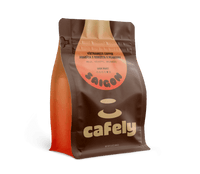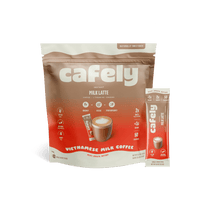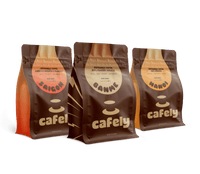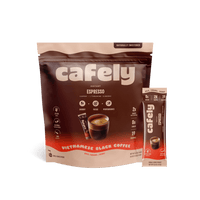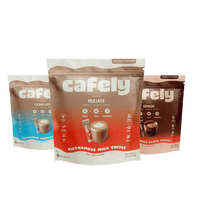From the bold, bittersweet phin-brewed robusta of Vietnam to the delicate, fruity pour-over of Ethiopia, no single “best” coffee exists.
What we can do is explore the landscapes, methods, and tastes that make each origin unique — and see how they all shape the culture we love.
Top 10 Countries With the Best Coffee
No one can say any one coffee is objectively the best. However, this coffee ranking we have here is consistent with global rankings for flavor, culture, and quality.
We're considering these popularity metrics, as well as our own opinions on the unique nature of each origin.
1. Brazil: The World's Leading Coffee Grower

Since Brazil is one of the largest countries in the world, it may be no surprise that it’s also the largest coffee producer.
This mass production can sometimes go hand-in-hand with low quality, but not in the case of Brazilian coffee. The beans are often exceptionally smooth, nutty, and chocolatey — a truly impressive showcasing of the flavors common among South American beans.
Within Brazil, there are a few famous coffee-growing regions, for instance, Minas Gerais and São Paulo.
Minas Gerais coffee is prized for its sweetness, with tasting notes for the beans often including caramel or toasted sugar.
São Paulo beans are a little nuttier, specifically sought out for their rich, creamy hazelnut notes.
2. Ethiopia: The Birthplace of Coffee
The legend of the origin of coffee centers around Kaldi, an Ethiopian goat herder.
Supposedly, he witnessed his goats being more energetic after eating the coffee berries, and took some to a local preacher who developed the berries into the drink we love around the world today.
Ethiopia focuses on arabica beans, while some western and central African regions focus a little more on robusta.
The tasting notes for Ethiopian arabica always include berries and sweet fruitiness.
The beans are harvested in Ethiopia between October and January, and are then processed and roasted before being rolled out.
3. Colombia: Renowned for Smooth, Balanced Beans
Next to Brazil, Colombia is another very prolific coffee-growing region, with its beans having a slightly different flavor profile.
Colombian coffee is often bright and fruity thanks to its high-altitude growing conditions, which bring out more complex flavors and higher perceived acidity.
This results in beans that, when brewed, produce delicate and enticing citrus and berry notes compared to the rich nuttiness of Brazilian coffee.
Another reason for these differences in flavors is the processing methods used. Colombian coffee is often wet processed (the skin and pulp are washed off the bean), while Brazilian coffee is typically dry processed (the fruit dries while still on the bean).
This process gives Colombian coffee a lighter body and mouthfeel, while Brazilian beans end up making a strong, full-bodied, and robust cup.
4. Yemen: Ancient Coffee Traditions
Yemeni coffee traditions are another place to see dry-processed coffee being used to its fullest.
As the berries are slowly dried in the hot sun, their flavors can concentrate into the bean at their core, leading to a rich and wine-like flavor.
Yemen is one of the first places in the world in which coffee was propagated: in the 15th century, Ethiopian plants were transplanted to Yemeni soil.
The coffee here is grown at exceptionally high altitudes, giving the beans acidity and brightness, plus complex sweetness due to the slower ripening that occurs in cooler temperatures.
5. Vietnam: Potent Robusta Aplenty

Vietnam is a notable inclusion on this list — it’s the second-largest coffee producer in the world.
In fact, Vietnamese crops make up around 80% of the world’s supply of robusta coffee beans.
Robusta beans are very popular in Vietnam, with the tradition of butter-roasting pairing beautifully with the locally adored phin brewer.
Together, these two create a very strong and highly caffeinated drink, which is often tamed ever so slightly with condensed milk and ice.
The unique brewing styles of the region don’t stop there — Vietnamese egg coffee is becoming internationally popular. The name is something of a misnomer, with a better name perhaps being “custard coffee.” This dessert drink consists of a strong black coffee with a whipped custard-like topping made from eggs and condensed milk.
6. Indonesia: An Archipelago of Coffee Microclimates
Indonesian coffee has a number of impressive tasting notes that make it popular.
The beans are often used as part of blends to create an overall flavor that’s complex and aromatic.
You might think you’ve never had Indonesian coffee before, but you likely have, and the beans have instead been labeled with one of these regions — Flores, Bali, Java, Sumatra, and Sulawesi.
These coffees, particularly Java variety and Sumatra coffee, are notable for their uniquely spiced and woody notes, pairing with their dark chocolate flavors to create a decadent beverage.
They also tend to have a syrupy mouthfeel thanks to the Giling Basah processing method, where the beans are washed clean of flesh, then dried to around 35% moisture content, before being hulled and further dried to a more usual percentage of moisture.
This method leads to beans that are a blue-green color before roasting, which is both unique and enticing.
7. Kenya: High-Elevation Coffee With Enticing Acidity
Kenyan coffees are often grown at particularly high elevations and, therefore, at lower temperatures.
The beans are higher in acidity than some others, and also take a longer time to ripen, leading to a more balanced sweetness.
The natural fruity and berry notes of African coffee are present in Kenyan arabica beans, with the higher elevation leading to more pronounced acidity.
This often manifests in lemony notes and an aftertaste that’s quite dry, similar to wine.
8. India: Low-Acidity & Sweet, Spicy Notes
India produces a mixture of both robusta and arabica beans in a range of different climates.
The most notable climate in the region is high-altitude rainforests, which impart a huge amount of moisture into the beans.
One Indian coffee that’s particularly popular is Monsoon Malabar — the beans are harvested before the monsoon season, and then left out in the rain for three to four months. This allows the crop to soak up lots of water, and the beans can swell and turn white.
This unique growing region furnishes the world with beans that are typically medium- to full-bodied and have a fairly low acidity, giving them sweet and sometimes slightly peppery notes in the final drink.
9. Mexico: Mild & Light, With Chocolate Notes
Mexican coffee is a real treat, especially since Mexican growers often produce rarer varietals like Typica and Bourbon.
Coffee produced in the region is diverse, and it would take all day to run through all the different flavors and aromas you can seek out.
To generalise a little, Mexican coffee tends to have a lighter body than beans from other regions. This allows nuanced flavors to shine through, with common tasting notes being chocolate, nuts, and citrus.
Oaxaca — a Mexican coffee-growing region — produces particularly sweet and fruity coffee, in which some people detect subtle cayenne pepper notes.
10. Jamaica: Blue Mountain, A Rare Treat
Blue Mountain coffee is one of the most famous and expensive coffees out there, and for good reason.
Coffee can only be sold under that name if it has been grown between 3,000 and 5,500 feet on the slopes of the Blue Mountain range in Jamaica. The region was formed through volcanic activity, meaning that the soil is rich in minerals and imbues unique flavors into the beans.
The coffee is particularly prized for being very mellow and having little to no bitterness.
Instead, it’s said to have a complex chocolate and nut flavor profile, alongside a subtle sweetness that creates a smooth drink.
The climate in the Blue Mountains is very cool and humid, which enhances the natural sweetness of the beans during ripening.
What Makes Coffee “The Best”? (It’s More Than Taste)
Many different factors directly influence the flavor of coffee, and by understanding how these influences occur, we can get a better appreciation of complex tasting notes in our cups.
Here, we’re going to break down some key pieces of knowledge that go into our rankings above.
Growing Conditions
A great place to start is where the beans originate from — the soil.
The growing conditions influence what compounds are distilled into the coffee cherry and, in turn, your cup. A great example of this is how elevation impacts the flavor.
When a single-origin coffee is grown at a higher altitude, two things happen.
First, the coffee beans naturally develop higher levels of acidity.
Second, because of the lower temperatures at high altitudes, they grow and ripen far more slowly than coffee grown at lower altitudes would.
Together, these result in a slow-growing plant that produces more flavorsome and complex beans.
Climate and soil are also relevant to the coffee cherries, since the soil is where the cherry draws its minerals from, and the climate directly influences the heat and humidity around the plant.
All these small-seeming factors change how the plant grows, leading to slight differences in the beans.
Processing Methods
Since coffee is such an ancient crop, there are a vast number of processing methods out there.
The most common are washed and natural, also known as wet and dry, respectively.
The washed process involves cleaning the skin and pulp of the coffee cherry off the pit, and allowing just the pit to sit and dry in the sun until it’s ready to be roasted.
The natural method doesn’t wash the fruit away, leaving the whole thing to sit in the sun. These two methods lead to different flavor characteristics, which are most commonly notable in the body of the coffee.
Naturally processed coffee tends to have a richer, bolder body with earthy notes, while washed coffee has a brighter, cleaner final flavor.
No one way is right or wrong; they just result in slight differences, and people may have a preference for one method over the other.
Other Processing Methods
There are more unusual processing methods out there, too, such as honey-processed coffee.
This method doesn’t include the use of honey, but rather the berries are peeled while the pulp is left mostly intact on the bean. This pulp, called the mucilage, is honey-like in color, hence the name of the method. The mucilage being left on the bean leads to a coffee with a balanced level of body and an enhanced, potent sweetness.
Weasel coffee is possibly the most unique of all and is one of the most expensive coffees around.
Culture & Brewing Techniques
The coffee culture of a region directly impacts how its coffee is harvested, processed, roasted, and brewed.
Turkish Cezve Brewing
In Turkey, coffee is prepared in a small pot called a cezve. Ultra-fine grounds are simmered and cooled several times, producing a dense, foamy brew. Dark roasts dominate, highlighting bittersweet caramel and nutty notes that suit the intense, short-extraction method.
Learn more about brewing Turkish coffee.
Vietnamese Phin Brewing
Vietnam’s street-side cafés and carts serve coffee through the phin — a slow-drip metal filter. Usually made with butter-roasted robusta, the result is strong, earthy, and high in caffeine, often sweetened with condensed milk for balance.
Learn more about Vietnamese coffee culture.
Italian Espresso
Italy pioneered espresso: a high-pressure extraction that delivers concentrated flavor in seconds.
Medium-to-dark roasts bring out chocolate, caramel, and nutty notes — the foundation for cappuccinos and lattes worldwide.
Ethiopian Coffee Ceremony
In Ethiopia, coffee is roasted, ground, and brewed in a clay jebena during communal ceremonies.
The process emphasizes fruit-forward arabica beans, offering bright, floral flavors tied closely to ritual and hospitality.
Flavor Profiles & Preferences
Different flavor profiles exist throughout the many coffee origins, so it makes sense that coffee lovers would find one that they prefer over the others.
If you’re just getting started, though, how would you know what notes are associated with different locales?
Here are some of the common tasting notes from popular coffee origins:

Why Vietnamese Coffee Stands Out
Vietnamese coffee stands apart from the rest of the world for a number of reasons.
While arabica is often favored by baristas, robusta is slowly getting the recognition it deserves.
By extension, Vietnamese coffee culture and traditions are getting that same recognition, too.
1. Cultural Significance
Coffee has a large cultural significance in Vietnam, and is a regular part of daily life rather than just being a beverage that you may or may not choose to have.
Phin filter brewing is the predominant choice among Vietnamese coffee lovers, and cafes selling the potent brew are very common.
2. Coffee Strength
The long, slow brewing time leads to an intensely potent coffee, which is typically brewed over ice.
It’s even more energizing with the addition of condensed milk, which is a very popular way to add sweetness and creaminess.
3. Type of Coffee
Finally, it would be a crime to discuss Vietnamese coffee without mentioning the stellar flavor of peaberry robusta beans.
Coffee made with peaberry robusta beans has an enhanced caffeine and flavor content, leading to a final drink with a rich and bittersweet flavor.
While arabica does have a place in Vietnamese coffee culture, robusta is still favored — it’s more bitter, more intense, and uniquely Vietnamese.
FAQs: What Country Has the Best Coffee?
Many countries out there claim to have the best coffee in the world, and we hope we’ve given you the knowledge you need to make your own decision. To clear a few other things up, here are some FAQs.
1. Where Can I Drink the Best Coffee in the World?
While the best coffee in the world is based on your preferences, some of the most popular picks are Ethiopia, Colombia, and Vietnam for authentic and high-quality coffee experiences.
2. What Is the Most Expensive Coffee in the World?
The most expensive coffee out there is Kopi Luwak (weasel coffee) from Indonesia. The delicate flavor of the coffee is sought after, despite the beans’ unappetizing processing.
3. Which Country Is the Richest in Coffee?
Brazil is the world’s largest coffee exporter, both in terms of how much money it makes from exporting coffee and the sheer volume of beans exported.
4. Which Coffee Is World-Famous Now?
Many coffees are very famous, but Colombian coffee is probably the most globally recognized for its smooth, nutty flavor.
5. What Country Has the Strongest Coffee?

Vietnam uses robusta coffee in many of its drinks due to the high caffeine content. Plus, the traditional brewing methods prioritise high extraction for a potent flavor.
6. What Is the Coffee Capital of the World?
This is up for debate, but Addis Ababa in Ethiopia is commonly considered the heart of worldwide coffee culture. Another competitor could be San Francisco, which has a long history of coffee culture, as well as being the location of the headquarters of Starbucks.
7. What Country Drinks the Most Coffee?
Per person, Finland has the highest coffee consumption in the world.
8. Which Country’s Arabica Coffee Is Best?
Ethiopian arabica beans are usually thought of as the best because of their uniquely fruity and floral flavors.
9. What Roast Levels Are Best for Global Coffee Styles?
Roasting is a complex science, but generally, lighter roasts are used to preserve and highlight original flavors, while dark roasts are preferred for very potent drinks like espresso.
10. Who Won the Best Coffee in the World?
Geisha beans from Panama are often among the top echelons of international competitions.
